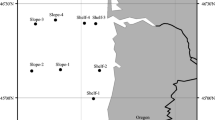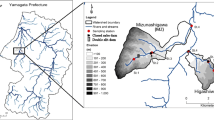Abstract
Reservoirs show contrasting chemical and biological spatial gradients due to the strong effect of the inflowing rivers on the whole ecosystem. However, the fate of dissolved organic matter (DOM) input from rivers along the reservoir water body is still unclear. Here, we characterized the composition of DOM in the Ter River–Sau Reservoir system (Spain), located in a watershed under anthropogenic pressures (urban wastewater effluents, intensive farming, agriculture). Water samples were collected in the river several kilometers upstream of the reservoir and during its travel throughout the water body until the dam. Absorbance and fluorescence spectroscopy with parallel factor analysis (PARAFAC) was used to characterize DOM. Based on three-dimensional excitation-emission matrices (EEMs), PARAFAC produced a six-component model, most of them related to human-derived DOM and showing significant spatial trends. A component showing major influence on the overall spectroscopy signal was associated with wastewater effluents and significantly correlated with environmental variables usually linked to DOM lability. Components trends showed a major discontinuity in the vicinity of the river plunge point (river–reservoir boundary), where the composition of DOM showed noticeable changes. Upstream from the plunge point, components related to human activity dominated the spectroscopy signal, while components related to autochthonous planktonic activity appeared downstream of the plunge point. This coincided with strong heterotrophic activity as revealed by oxygen undersaturation and nutrient concentration changes. Fluorescence indices also supported a strong signature of human-derived DOM in the system and pointed to the plunge point as a likely hot spot for DOM processing.





Similar content being viewed by others
Availability of data and material
All data generated in this study is available from the authors upon request.
References
Abril G, Borges AV (2019) Ideas and perspectives: carbon leaks from flooded land: do we need to replumb the inland water active pipe? Biogeosciences 16:769–784. https://doi.org/10.5194/bg-16-769-2019
Assireu AT, Alcântara E, Novo EMLM, Roland F, Pacheco FS, Stech JL (2011) Lorenzzetti JA (2011) Hydro-physical processes at the plunge point: an analysis using satellite and in situ data. Hydrol Earth Syst Sci 15:3689–3700. https://doi.org/10.5194/hess-15-3689-2011
Butturini A (2021) Fuirosos stream (NE Iberian Peninsula): for how much longer? Limnetica 40:205–222. https://doi.org/10.23818/limn.40.14
Coble PG, Spencer RGM, Baker A, Reynolds DM (2014) Aquatic Organic Matter Fluorescence. Aquatic Organic Matter Fluorescence. Cambridge University Press, Cambridge, pp 75–122
Comerma M, García JC, Romero M et al (2003) Carbon flow dynamics in the pelagic community of the Sau Reservoir (Catalonia, NE Spain). Hydrobiologia. Springer, New York, pp 87–98
del Giorgio PA, Pace ML (2008) Relative independence of organic carbon transport and processing in a large temperate river: the Hudson River as both pipe and reactor. Limnol Oceanogr 53:185–197. https://doi.org/10.4319/lo.2008.53.1.0185
Derrien M, Lee MH, Choi K et al (2020) Tracking the evolution of particulate organic matter sources during summer storm events via end-member mixing analysis based on spectroscopic proxies. Chemosphere 252:126445. https://doi.org/10.1016/j.chemosphere.2020.126445
Fellman JB, D’Amore DV, Hood E, Boone RD (2008) Fluorescence characteristics and biodegradability of dissolved organic matter in forest and wetland soils from coastal temperate watersheds in southeast Alaska. Biogeochemistry 88:169–184. https://doi.org/10.1007/s10533-008-9203-x
Fellman JB, Hood E, Spencer RGM (2010) Fluorescence spectroscopy opens new windows into dissolved organic matter dynamics in freshwater ecosystems: a review. Limnol Oceanogr 55:2452–2462. https://doi.org/10.4319/lo.2010.55.6.2452DOC:DON
Fischer HB, List EJ, Koh RCY et al (1979) Mixing in Inland and Coastal Waters. Academic Press, New York
Gasol JM, Comerma M, García JC et al (2002) A transplant experiment to identify the factors controlling bacterial abundance, activity, production, and community composition in a eutrophic canyon-shaped reservoir. Limnol Oceanogr 47:62–77. https://doi.org/10.4319/lo.2002.47.1.0062
Han Z, Xiao M, Yue F et al (2021) Seasonal variations of dissolved organic matter by fluorescent analysis in a typical river catchment in Northern China. Water 13:494. https://doi.org/10.3390/w13040494
Hayes NM, Deemer BR, Corman JR et al (2017) Key differences between lakes and reservoirs modify climate signals: a case for a new conceptual model. Limnol Oceanogr Lett 2:47–62. https://doi.org/10.1002/lol2.10036
Huang L, Dong H, Jiang H et al (2016) Relative importance of advective flow versus environmental gradient in shaping aquatic ammonium oxidizers near the Three Gorges Dam of the Yangtze River, China. Environ Microbiol Rep 8:667–674. https://doi.org/10.1111/1758-2229.12420
Hunt AP, Parry JD, Hamilton-Taylor J (2000) Further evidence of elemental composition as an indicator of the bioavailability of humic substances to bacteria. Limnol Oceanogr 45:237–241. https://doi.org/10.4319/lo.2000.45.1.0237
Jaffé R, McKnight D, Maie N et al (2008) Spatial and temporal variations in DOM composition in ecosystems: the importance of long-term monitoring of optical properties. J Geophys Res Biogeosci 113:4032. https://doi.org/10.1029/2008JG000683
Kadjeski M, Fasching C, Xenopoulos MA (2020) Synchronous biodegradability and production of dissolved organic matter in two streams of varying land use. Front Microbiol 11:568629. https://doi.org/10.3389/fmicb.2020.568629
Kothawala DN, Murphy KR, Stedmon CA et al (2013) Inner filter correction of dissolved organic matter fluorescence. Limnol Oceanogr Methods 11:616–630. https://doi.org/10.4319/lom.2013.11.616
López P, Marcé R, Armengol J (2011) Net heterotrophy and CO2 evasion from a productive calcareous reservoir: adding complexity to the metabolism-CO2 evasion issue. J Geophys Res 116:G02021. https://doi.org/10.1029/2010JG001614
Marcé R, Moreno-Ostos E, Armengol J (2008a) The role of river inputs on the hypolimnetic chemistry of a productive reservoir: Implications for management of anoxia and total phosphorus internal loading. Lake Reserv Manag 24:87–98. https://doi.org/10.1080/07438140809354053
Marcé R, Moreno-Ostos E, López P, Armengol J (2008b) The role of allochthonous inputs of dissolved organic carbon on the hypolimnetic oxygen content of reservoirs. Ecosystems 11:1035–1053. https://doi.org/10.1007/s10021-008-9177-5
Marcé R, Rodríguez-Arias MÀ, García JC, Armengol J (2010) El Niño Southern Oscillation and climate trends impact reservoir water quality. Glob Chang Biol 16:2857–2865. https://doi.org/10.1111/j.1365-2486.2010.02163.x
McKnight DM, Boyer EW, Westerhoff PK et al (2001) Spectrofluorometric characterization of dissolved organic matter for indication of precursor organic material and aromaticity. Limnol Oceanogr 46:38–48. https://doi.org/10.4319/lo.2001.46.1.0038
Murphy J, Riley JP (1962) A modified single solution method for the determination of phosphate in natural waters. Anal Chim Acta 27:31–36. https://doi.org/10.1016/S0003-2670(00)88444-5
Murphy KR, Butler KD, Spencer RGM et al (2010) Measurement of dissolved organic matter fluorescence in aquatic environments: an interlaboratory comparison. Environ Sci Technol 44:9405–9412. https://doi.org/10.1021/es102362t
Murphy KR, Hambly A, Singh S et al (2011) Organic matter fluorescence in municipal water recycling schemes: toward a unified PARAFAC model. Environ Sci Technol 45:2909–2916. https://doi.org/10.1021/es103015e
Murphy KR, Stedmon CA, Graeber D, Bro R (2013) Fluorescence spectroscopy and multi-way techniques. PARAFAC Anal Methods 5:6557–6566
Murphy KR, Stedmon CA, Wenig P, Bro R (2014) OpenFluor—an online spectral library of auto-fluorescence by organic compounds in the environment. Anal Methods 6:658–661. https://doi.org/10.1039/c3ay41935e
Parlanti E, Wörz K, Geoffroy L, Lamotte M (2000) Dissolved organic matter fluorescence spectroscopy as a tool to estimate biological activity in a coastal zone submitted to anthropogenic inputs. Org Geochem 31:1765–1781. https://doi.org/10.1016/S0146-6380(00)00124-8
Pradeep Ram AS, Keshri J, Sime-Ngando T (2019) Distribution patterns of bacterial communities and their potential link to variable viral lysis in temperate freshwater reservoirs. Aquat Sci 81:72. https://doi.org/10.1007/s00027-019-0669-5
Qin Y, Tang Q, Lu L et al (2021) Changes in planktonic and sediment bacterial communities under the highly regulated dam in the mid-part of the Three Gorges Reservoir. Appl Microbiol Biotechnol 105:839–852. https://doi.org/10.1007/s00253-020-11047-3
Rizo EZC, Liu P, Niu H et al (2020) Zooplankton in a continuous waterscape: environmental and spatial factors shaping spring zooplankton community structure in a large canyon reservoir at the tropic of cancer. Hydrobiologia 847:3621–3635. https://doi.org/10.1007/s10750-020-04380-1
Rueda FJ, Fleenor WE, de Vicente I (2007) Pathways of river nutrients towards the euphotic zone in a deep-reservoir of small size: uncertainty analysis. Ecol Modell 202:345–361. https://doi.org/10.1016/j.ecolmodel.2006.11.006
Sepp M, Kõiv T, Nõges P, Nõges T (2019) The role of catchment soils and land cover on dissolved organic matter (DOM) properties in temperate lakes. J Hydrol 570:281–291. https://doi.org/10.1016/j.jhydrol.2019.01.012
Šimek K, Comerma M, García JC et al (2011) The effect of river water circulation on the distribution and functioning of reservoir microbial communities as determined by a relative distance approach. Ecosystems 14:1–14. https://doi.org/10.1007/s10021-010-9388-4
Solórzano L (1969) Determination of ammonia in natural water by the phenolhypochlorite method. Limnol Oceanogr 14:799–801. https://doi.org/10.4319/lo.1969.14.5.0799
Tranvik LJ, Cole JJ, Prairie YT (2018) The study of carbon in inland waters-from isolated ecosystems to players in the global carbon cycle. Limnol Oceanogr Lett 3:41–48. https://doi.org/10.1002/lol2.10068
Ulseth AJ, Hall RO (2015) Dam tailwaters compound the effects of reservoirs on the longitudinal transport of organic carbon in an arid river. Biogeosciences 12:4345–4359. https://doi.org/10.5194/bg-12-4345-2015
Vazquez E, Amalfitano S, Fazi S, Butturini A (2011) Dissolved organic matter composition in a fragmented Mediterranean fluvial system under severe drought conditions. Biogeochemistry 102:59–72. https://doi.org/10.1007/s10533-010-9421-x
Vidal J, Marcé R, Serra T et al (2012) Localized algal blooms induced by river inflows in a canyon type reservoir. Aquat Sci 74:315–327. https://doi.org/10.1007/s00027-011-0223-6
Weishaar JL, Aiken GR, Bergamaschi BA et al (2003) Evaluation of specific ultraviolet absorbance as an indicator of the chemical composition and reactivity of dissolved organic carbon. Environ Sci Technol 37:4702–4708. https://doi.org/10.1021/es030360x
Weissenberger S, Lucotte M, Houel S et al (2010) Modeling the carbon dynamics of the La Grande hydroelectric complex in northern Quebec. Ecol Modell 221:610–620. https://doi.org/10.1016/j.ecolmodel.2009.10.037
Williams CJ, Yamashita Y, Wilson HF et al (2010) Unraveling the role of land use and microbial activity in shaping dissolved organic matter characteristics in stream ecosystems. Limnol Oceanogr 55:1159–1171. https://doi.org/10.4319/lo.2010.55.3.1159
Wilson HF, Xenopoulos MA (2009) Effects of agricultural land use on the composition of fluvial dissolved organic matter. Nat Geosci 2:37–41. https://doi.org/10.1038/ngeo391
Wohl E (2013) Landscape-scale carbon storage associated with beaver dams. Geophys Res Lett 40:3631–3636. https://doi.org/10.1002/grl.50710
Yates CA, Johnes PJ, Owen AT et al (2019) Variation in dissolved organic matter (DOM) stoichiometry in U.K. freshwaters: assessing the influence of land cover and soil C: N ratio on DOM composition. Limnol Oceanogr 64:2328–2340. https://doi.org/10.1002/lno.11186
Zsolnay A, Baigar E, Jimenez M et al (1999) Differentiating with fluorescence spectroscopy the sources of dissolved organic matter in soils subjected to drying. Chemosphere 38:45–50. https://doi.org/10.1016/S0045-6535(98)00166-0
Acknowledgements
We thank Gonzalo Gonzalez, Jaime Ordóñez, and Maria de los Angeles Gallegos for support in the lab and during the fieldwork.
Funding
NL benefited from a grant from the Erasmus program of the European Commission. Participation of RM was supported by the Generalitat de Catalunya through the Consolidated Research Group 2017SGR1124, and by the CERCA program.
Author information
Authors and Affiliations
Contributions
Conceptualization, RM; methodology, NL and RM; formal analysis, NL and RM; resources, RM; writing—original draft preparation, RM; writing—review and editing, RM and LV; supervision, RM; funding acquisition, RM. All authors have read and agreed to the published version of the manuscript.
Corresponding author
Ethics declarations
Conflict of interest
The authors have no conflicts of interest to declare that are relevant to the content of this article.
Code availability
Not applicable.
Ethics approval
Not applicable.
Consent to participate
Not applicable.
Consent for publication
Not applicable.
Additional information
Publisher's Note
Springer Nature remains neutral with regard to jurisdictional claims in published maps and institutional affiliations.
Rights and permissions
About this article
Cite this article
Marcé, R., Verdura, L. & Leung, N. Dissolved organic matter spectroscopy reveals a hot spot of organic matter changes at the river–reservoir boundary. Aquat Sci 83, 67 (2021). https://doi.org/10.1007/s00027-021-00823-6
Received:
Accepted:
Published:
DOI: https://doi.org/10.1007/s00027-021-00823-6




